Design, Synthesis, and Anti-PVY Biological Activity of 1,3,5-Triazine Derivatives Containing Piperazine Structure
Abstract
1. Introduction
2. Results and Discussion
2.1. Chemistry
2.2. Anti-PVY Activity In Vivo
2.3. 3D-QSAR Analysis
2.4. Synthesis and Activity Test of Target Compound C35
2.5. Molecular Docking Analysis and MD Simulations
2.5.1. Molecular Docking
2.5.2. MD Simulations
3. Materials and Methods
3.1. Instruments and Chemicals
3.1.1. General Procedures for Preparing Intermediates X, Y, and Z
3.1.2. General Procedures for Preparing Intermediates A1–A35
3.1.3. General Procedures for Preparing the Intermediates B1–B35
3.1.4. General Procedures for the Preparation of the Title Compounds C1–C35
3.2. Antiviral Activity Assay
3.3. 3D-QSAR
3.4. Molecular Docking and MD Simulations
4. Conclusions
Supplementary Materials
Author Contributions
Funding
Institutional Review Board Statement
Data Availability Statement
Conflicts of Interest
References
- Smith, K.M. Composite nature of certain potato viruses of the mosaic group. Nature 1931, 127, 702. [Google Scholar] [CrossRef]
- Sun, Z.R.; Wei, C.L.; Wu, S.K.; Zhang, W.B.; Song, R.J.; Hu, D.Y. Synthesis, anti-potato virus Y activities, and interaction mechanisms of novel quinoxaline derivatives bearing dithioacetal moiety. J. Agric. Food Chem. 2022, 70, 7029–7038. [Google Scholar] [CrossRef] [PubMed]
- Deja-Sikora, E.; Mercy, L.; Baum, C.; Hrynkiewicz, K. The contribution of endomycorrhiza to the performance of potato virus Y-infected solanaceous plants: Disease alleviation or exacerbation? Front. Microbiol. 2019, 10, 516. [Google Scholar] [CrossRef] [PubMed]
- Nanayakkara, U.; Nie, X.; Giguère, M.-A.; Zhang, J.; Pelletier, Y. Chenopodium album l. As a host for potato virus y (pvy) in new brunswick, canada. Am. J. Potato Res. 2012, 89, 245–247. [Google Scholar] [CrossRef]
- Kežar, A.; Kavčič, L.; Polák, M.; Nováček, J.; Gutiérrez-Aguirre, I.; Žnidarič, M.T.; Coll, A.; Stare, K.; Gruden, K.; Ravnikar, M.; et al. Structural basis for the multitasking nature of the potato virus Y coat protein. Sci. Adv. 2019, 5, eaaw3808. [Google Scholar] [CrossRef] [PubMed]
- Hofius, D.; Maier Annette, T.; Dietrich, C.; Jungkunz, I.; Börnke, F.; Maiss, E.; Sonnewald, U. Capsid protein-mediated recruitment of host dnaj-like proteins is required for potato virus y infection in tobacco plants. J. Virol. 2007, 81, 11870–11880. [Google Scholar] [CrossRef] [PubMed]
- Feki, S.; Loukili, M.J.; Triki-Marrakchi, R.; Karimova, G.; Old, I.; Ounouna, H.; Nato, A.; Nato, F.; Guesdon, J.L.; Lafaye, P.; et al. Interaction between tobacco ribulose-l,5-biphosphate carboxylase/oxygenase large subunit (RubisCO-LSU) and the PVY Coat Protein (PVY-CP). Eur. J. Plant Pathol. 2005, 112, 221–234. [Google Scholar] [CrossRef]
- Fedorkin, O.N.; Merits, A.; Lucchesi, J.; Solovyev, A.G.; Saarma, M.; Morozov, S.Y.; Mäkinen, K. Complementation of the movement-deficient mutations in potato virus x: Potyvirus coat protein mediates cell-to-cell trafficking of c-terminal truncation but not deletion mutant of potexvirus coat protein. Virology 2000, 270, 31–42. [Google Scholar] [CrossRef]
- Wu, X.Y.; Ji, Z.S. An overview on plant viral diseases and antiviral agents. World Pestic. 2021, 43, 17–24. [Google Scholar] [CrossRef]
- Sheppard, S. Moroxydine: The story of a mislaid antiviral. Acta Derm. Venereol. 1994, 183, 1–9. [Google Scholar] [CrossRef]
- Magri, A.; Reilly, R.; Scalacci, N.; Radi, M.; Hunter, M.; Ripoll, M.; Patel, A.H.; Castagnolo, D. Rethinking the old antiviral drug moroxydine: Discovery of novel analogues as anti-hepatitis C virus (HCV) agents. Bioorg. Med. Chem. Lett. 2015, 25, 5372–5376. [Google Scholar] [CrossRef] [PubMed]
- Yu, X.B.; Hao, K.; Li, J.; Chen, X.H.; Wang, G.X.; Ling, F. Effects of moroxydine hydrochloride and ribavirin on the cellular growth and immune responses by inhibition of GCRV proliferation. Res. Vet. Sci. 2018, 117, 37–44. [Google Scholar] [CrossRef] [PubMed]
- Yan, Y.; Huang, M.; Wang, L.; Xue, W.; Xie, X.; Li, X. Insights into a rapid screening method for anti-cucumber mosaic virus compounds. J. Virol. Methods 2022, 301, 114402. [Google Scholar] [CrossRef] [PubMed]
- Sapozhnikova, I.M.; Ulomsky, E.N.; Rusinov, V.L.; Chupakhin, O.N.; Stepanov, A.V.; Savateeva-Lyubimova, T.N.; Sivak, K.V. 3-Cyanoazolo[5,1-c][1,2,4]triazines: Synthesis and antiviral activity. Chem. Heterocycl. Comp. 2021, 57, 467–472. [Google Scholar] [CrossRef]
- Wei, C.L.; Zhang, J.; Shi, J.; Gan, X.H.; Hu, D.Y.; Song, B.A. Synthesis, antiviral activity, and induction of plant resistance of indole analogues bearing dithioacetal moiety. J. Agric. Food Chem. 2019, 67, 13882–13891. [Google Scholar] [CrossRef]
- Kaur, R.; Kumar, K. Synthetic and medicinal perspective of quinolines as antiviral agents. Eur. J. Med. Chem. 2021, 215, 113220. [Google Scholar] [CrossRef]
- Hu, F.; Cheng, X.; Niu, Z.; Yang, X.; Li, D.; Wan, L.; Li, J.; Liu, B.; Zou, X.; Yang, H.; et al. Synthesis and herbicidal activities of 3-(4-chloro-2-fluoro-5-substituted phenyl) benzo[d][1,2,3]triazin-4(3h)-one derivatives. J. Heterocycl. Chem. 2015, 52, 793–801. [Google Scholar] [CrossRef]
- Gardner, G.; Sanborn, J.R.; Goss, J.R. N-alkylaryltriazine herbicides: A possible link between triazines and phenylureas. Weed Sci. 1987, 35, 763–769. [Google Scholar] [CrossRef]
- Schuster, G. Verstärkung der antiphytoviralen wirkung von 2,4-dioxohexahydro-l,3,5-triazin durch kombination mit verbindungen mit guanidinstruktur. J. Phytopathol. 1983, 106, 262–271. [Google Scholar] [CrossRef]
- Morandini, A.; Leonetti, B.; Riello, P.; Sole, R.; Gatto, V.; Caligiuri, I.; Rizzolio, F.; Beghetto, V. Synthesis and antimicrobial evaluation of bis-morpholine triazine quaternary ammonium salts. ChemMedChem 2021, 16, 3172–3176. [Google Scholar] [CrossRef]
- Morandini, A.; Spadati, E.; Leonetti, B.; Sole, R.; Gatto, V.; Rizzolio, F.; Beghetto, V. Sustainable triazine-derived quaternary ammonium salts as antimicrobial agents. RSC Adv. 2021, 11, 28092–28096. [Google Scholar] [CrossRef] [PubMed]
- Dinesh Kumar, S.; Park, J.H.; Kim, H.S.; Seo, C.D.; Ajish, C.; Kim, E.Y.; Lim, H.-S.; Shin, S.Y. Cationic, amphipathic small molecules based on a triazine-piperazine-triazine scaffold as a new class of antimicrobial agents. Eur. J. Med. Chem. 2022, 243, 114747. [Google Scholar] [CrossRef] [PubMed]
- Tang, X.; Su, S.; Chen, M.; He, J.; Xia, R.; Guo, T.; Chen, Y.; Zhang, C.; Wang, J.; Xue, W. Novel chalcone derivatives containing a 1,2,4-triazine moiety: Design, synthesis, antibacterial and antiviral activities. RSC Adv. 2019, 9, 6011–6020. [Google Scholar] [CrossRef] [PubMed]
- Shuyun Zhang, H.L.; Wang, L.; Li, Z.; Wang, B. Studies on the synthesis, structural characterization and biological activities of novel caffeine derivatives containing substituted-piperazine moiety. Chin. J. Org. Chem. 2021, 41, 4075–4082. [Google Scholar] [CrossRef]
- Jiang, D.H.; Chen, J.X.; Zan, N.N.; Li, C.Y.; Hu, D.Y.; Song, B.A. Discovery of novel chromone derivatives containing a sulfonamide moiety as anti-tocv agents through the tomato chlorosis virus coat protein-oriented screening method. J. Agric. Food Chem. 2021, 69, 12126–12134. [Google Scholar] [CrossRef]
- Jiang, D.H.; Zhang, J.; He, H.F.; Li, J.; Hu, D.Y.; Song, B.A. Discovery of novel chromone derivatives containing a sulfonamide moiety as potential anti-TSWV agents. Bioorg. Med. Chem. Lett. 2021, 53, 128431. [Google Scholar] [CrossRef]
- Yuan, T.; Wang, Z.; Liu, D.; Zeng, H.; Liang, J.; Hu, D.; Gan, X. Ferulic acid derivatives with piperazine moiety as potential antiviral agents. Pest. Manag. Sci. 2022, 78, 1749–1758. [Google Scholar] [CrossRef]
- Del Rosario García-Lozano, M.; Dragoni, F.; Gallego, P.; Mazzotta, S.; López-Gómez, A.; Boccuto, A.; Martínez-Cortés, C.; Rodríguez-Martínez, A.; Pérez-Sánchez, H.; Manuel Vega-Pérez, J.; et al. Piperazine-derived small molecules as potential flaviviridae ns3 protease inhibitors. In vitro antiviral activity evaluation against zika and dengue viruses. Bioorg. Chem. 2023, 133, 106408. [Google Scholar] [CrossRef]
- Tahir, S.; Mahmood, T.; Dastgir, F.; Haq, I.-U.; Waseem, A.; Rashid, U. Design, synthesis and anti-bacterial studies of piperazine derivatives against drug resistant bacteria. Eur. J. Med. Chem. 2019, 166, 224–231. [Google Scholar] [CrossRef]
- Naikal James Prameela, S.; Jilla, L.; Vanguru, S. Synthesis of novel piperazine tethered benzocycloheptenone hybrids and their antimicrobial evaluation. J. Heterocycl. Chem. 2020, 57, 308–316. [Google Scholar] [CrossRef]
- Pospisilova, S.; Malik, I.; Curillova, J.; Michnova, H.; Cerna, L.; Padrtova, T.; Hosek, J.; Pecher, D.; Cizek, A.; Jampilek, J. Insight into antimicrobial activity of substituted phenylcarbamoyloxypiperazinylpropanols. Bioorg. Chem. 2020, 102, 104060. [Google Scholar] [CrossRef] [PubMed]
- Patil, M.; Noonikara Poyil, A.; Joshi, S.D.; Patil, S.A.; Patil, S.A.; Bugarin, A. Design, synthesis, and molecular docking study of new piperazine derivative as potential antimicrobial agents. Bioorg. Chem. 2019, 92, 103217. [Google Scholar] [CrossRef] [PubMed]
- Yan, L.H.; Du, F.Y.; Li, X.M.; Yang, S.Q.; Wang, B.G.; Li, X. Antibacterial indole diketopiperazine alkaloids from the deep-sea cold seep-derived fungus aspergillus chevalieri marine drugs. Mar. Drugs 2023, 21, 195. [Google Scholar] [CrossRef] [PubMed]
- Shen, Y.; Wang, J.Y.; Song, G.H. Ionic liquid-supported synthesis of piperazine derivatives as potential insecticides. Mol. Divers. 2014, 18, 195–202. [Google Scholar] [CrossRef]
- Samaritoni, J.G.; Demeter, D.A.; Gifford, J.M.; Watson, G.B.; Kempe, M.S.; Bruce, T.J. Dihydropiperazine neonicotinoid compounds. Synthesis and insecticidal activity. J. Agric. Food Chem. 2003, 51, 3035–3042. [Google Scholar] [CrossRef]
- Xu, G.; Yang, X.; Jiang, B.; Lei, P.; Liu, X.; Wang, Q.; Zhang, X.; Ling, Y. Synthesis and bioactivities of novel piperazine-containing 1,5-Diphenyl-2-penten-1-one analogues from natural product lead. Bioorg. Med. Chem. Lett. 2016, 26, 1849–1853. [Google Scholar] [CrossRef]
- Cai, M.; Li, Z.; Fan, F.; Huang, Q.; Shao, X.; Song, G. Design and synthesis of novel insecticides based on the serotonergic ligand 1-[(4-aminophenyl)ethyl]-4-[3-(trifluoromethyl) phenyl]piperazine (PAPP). J. Agric. Food Chem. 2010, 58, 2624–2629. [Google Scholar] [CrossRef]
- Shen, Y.; Zou, T.; Yang, J.; Xu, Z.; Wang, H.; Xiao, Z.; Luo, L.; Lei, H.; Sun, Y. Preparation of N-(4-amino-6-methyltriazin-2-yl)morpholine Antigen Based on Triazine Ring Structure, Antibody. CN108059622 A, 22 May 2018. [Google Scholar]
- Dao, P.; Garbay, C.; Chen, H. Regioselective synthesis of imidazo[1,2-a][1,3,5]triazines and 3,4-dihydroimidazo[1,2-a][1,3,5]triazines from [1,3,5]triazin-2,4-diamines. Tetrahedron 2013, 69, 3867–3871. [Google Scholar] [CrossRef]
- Saczewski, F.; Bułakowska, A. Synthesis of 2, 4-diamino-1, 3, 5-triazine analogues of methotrexate with potential antitumor activity. Pol. J.Chem. 2005, 79, 739–748. [Google Scholar] [CrossRef]
- Mandalapu, D.; Kushwaha, B.; Gupta, S.; Krishna, S.; Srivastava, N.; Shukla, M.; Singh, P.; Chauhan, B.S.; Goyani, R.; Maikhuri, J.P.; et al. Substituted carbamothioic amine-1-carbothioic thioanhydrides as novel trichomonicidal fungicides: Design, synthesis, and biology. Eur. J. Med. Chem. 2018, 143, 632–645. [Google Scholar] [CrossRef]
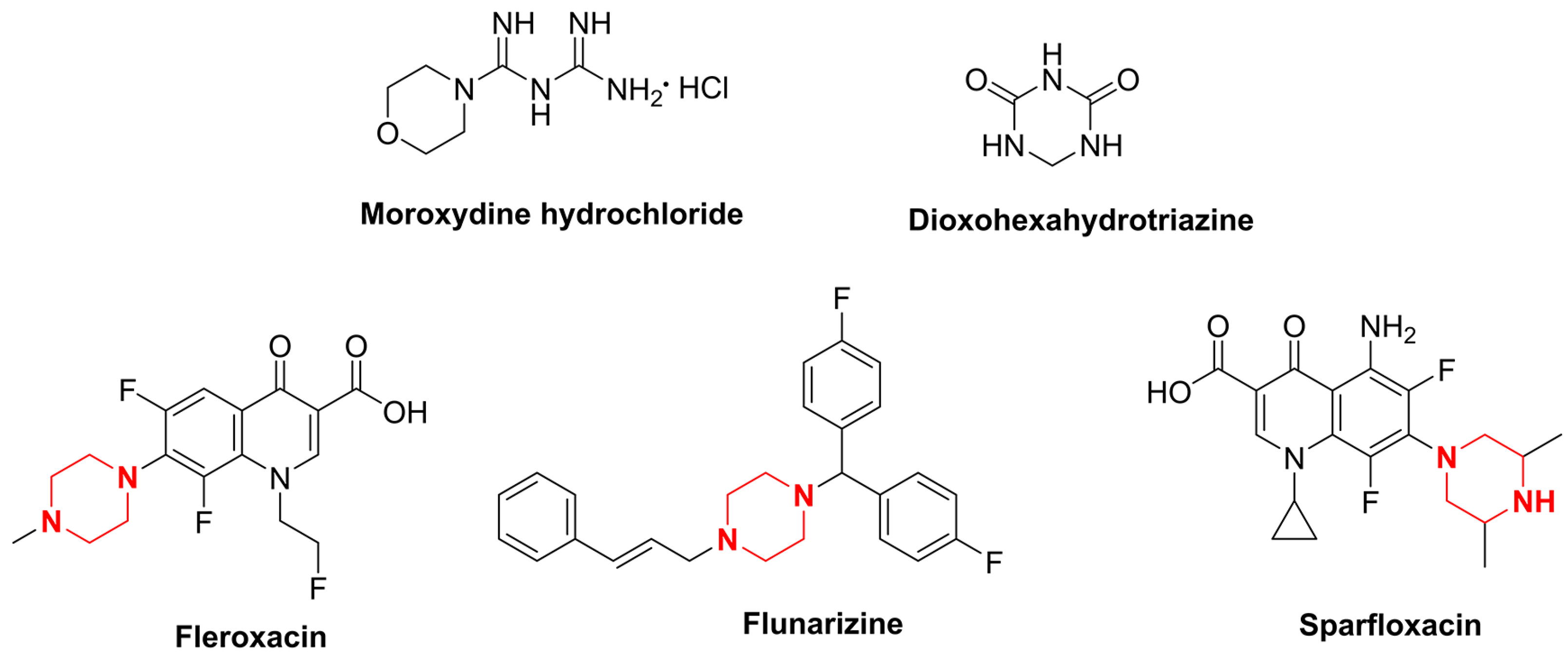

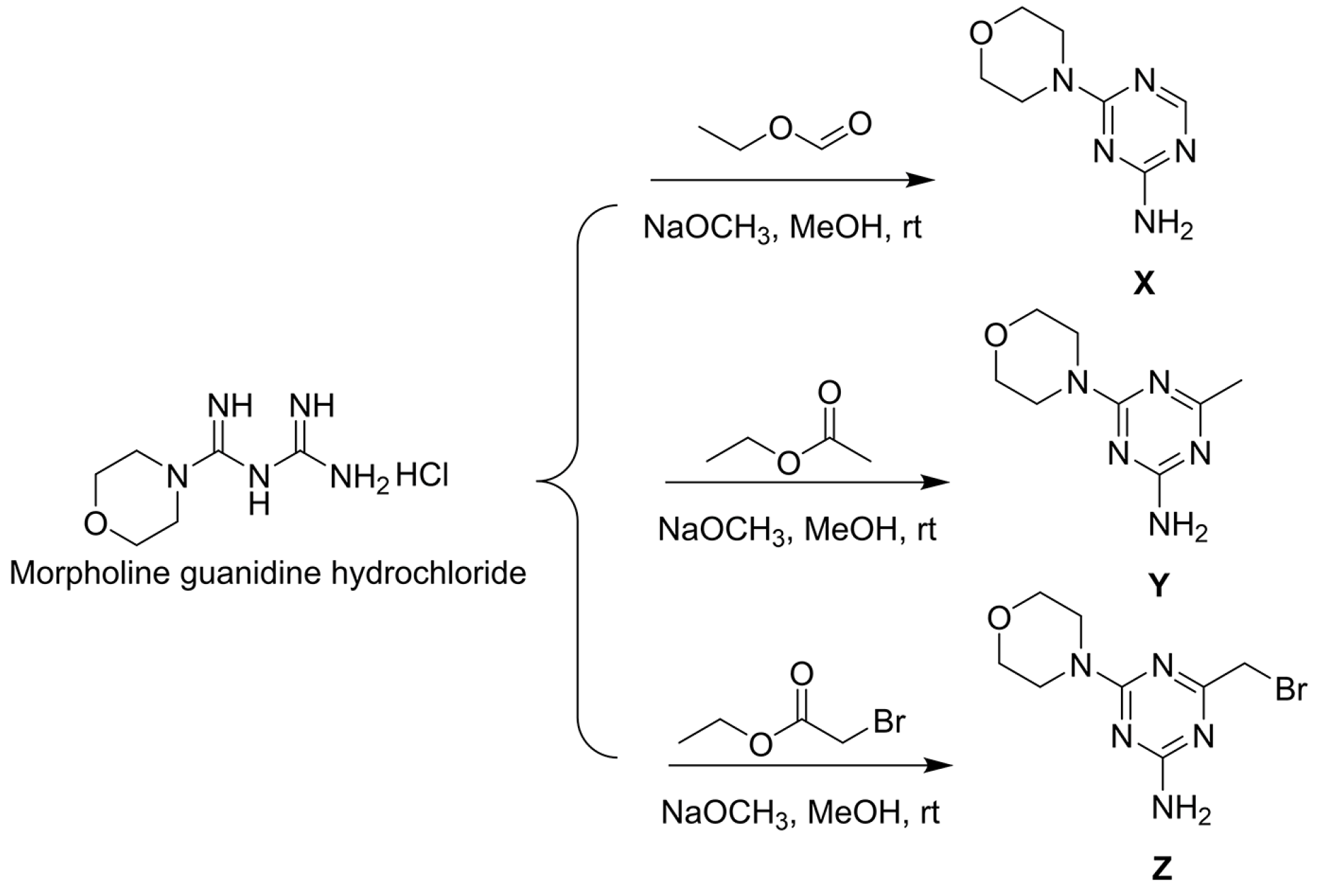
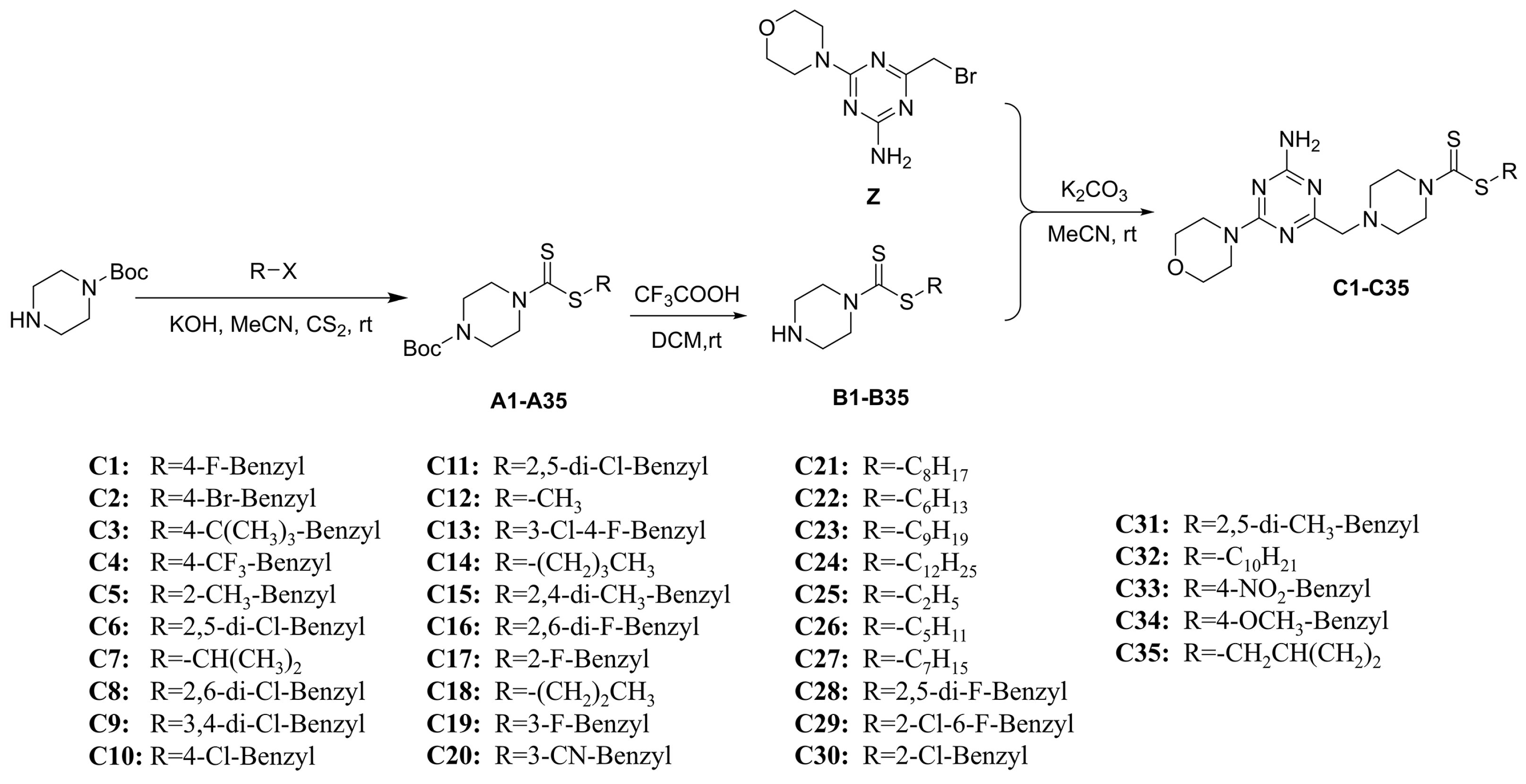
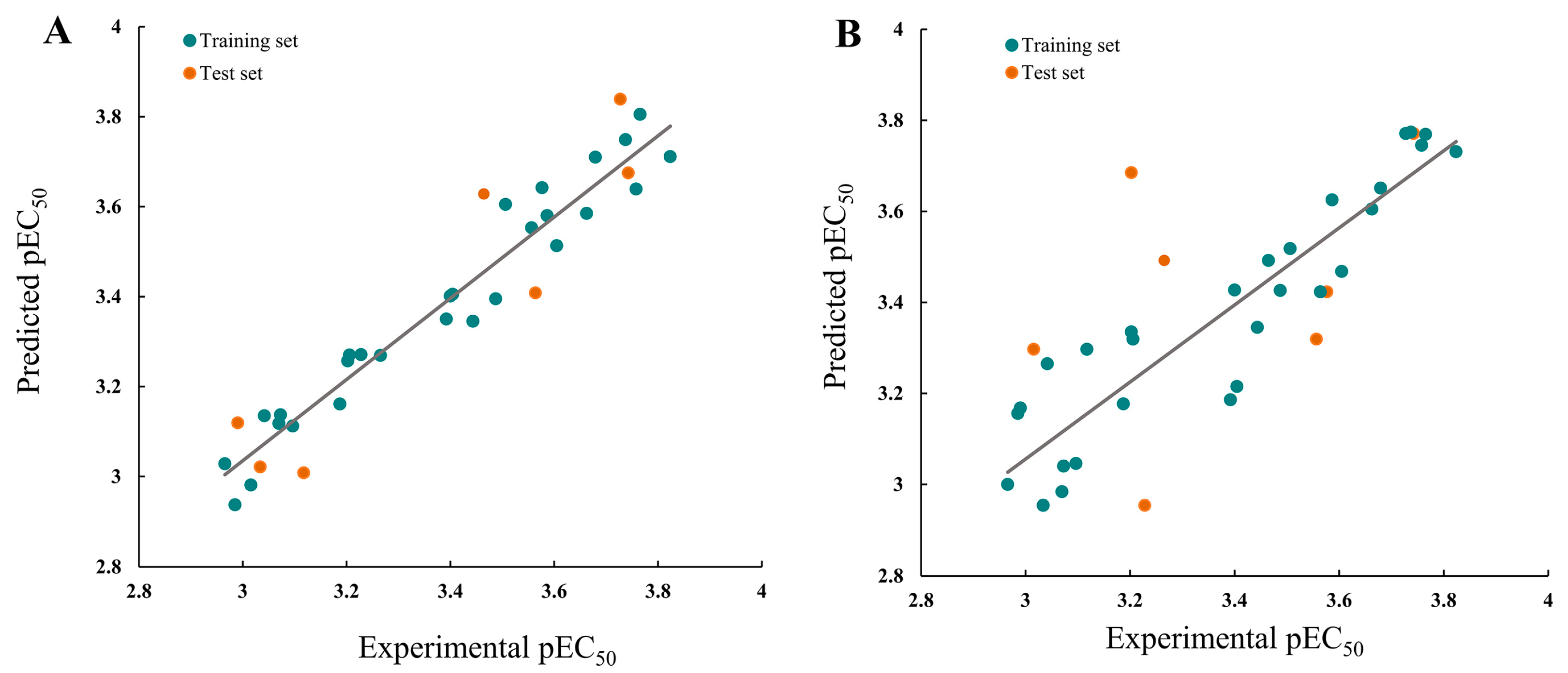


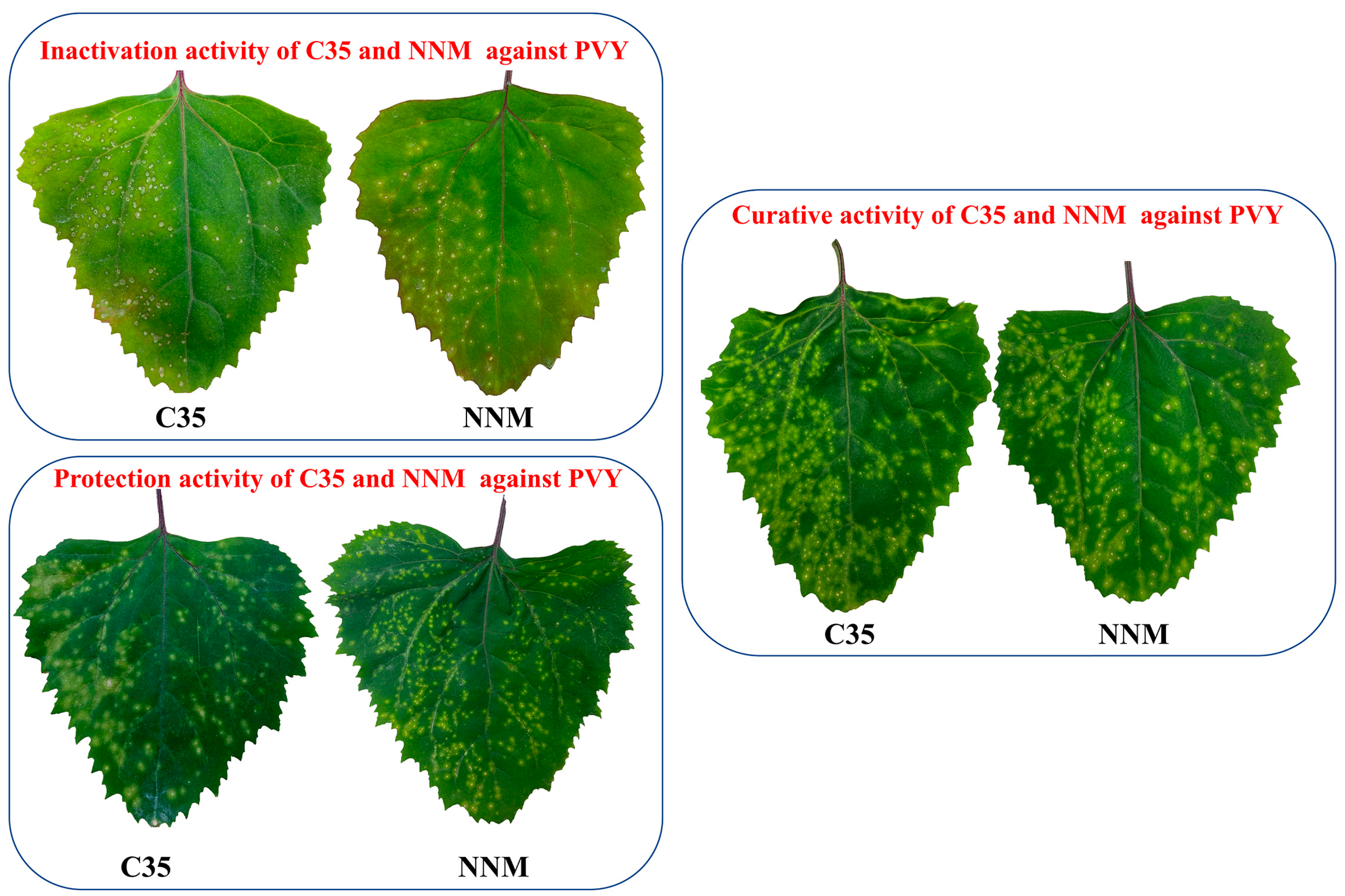

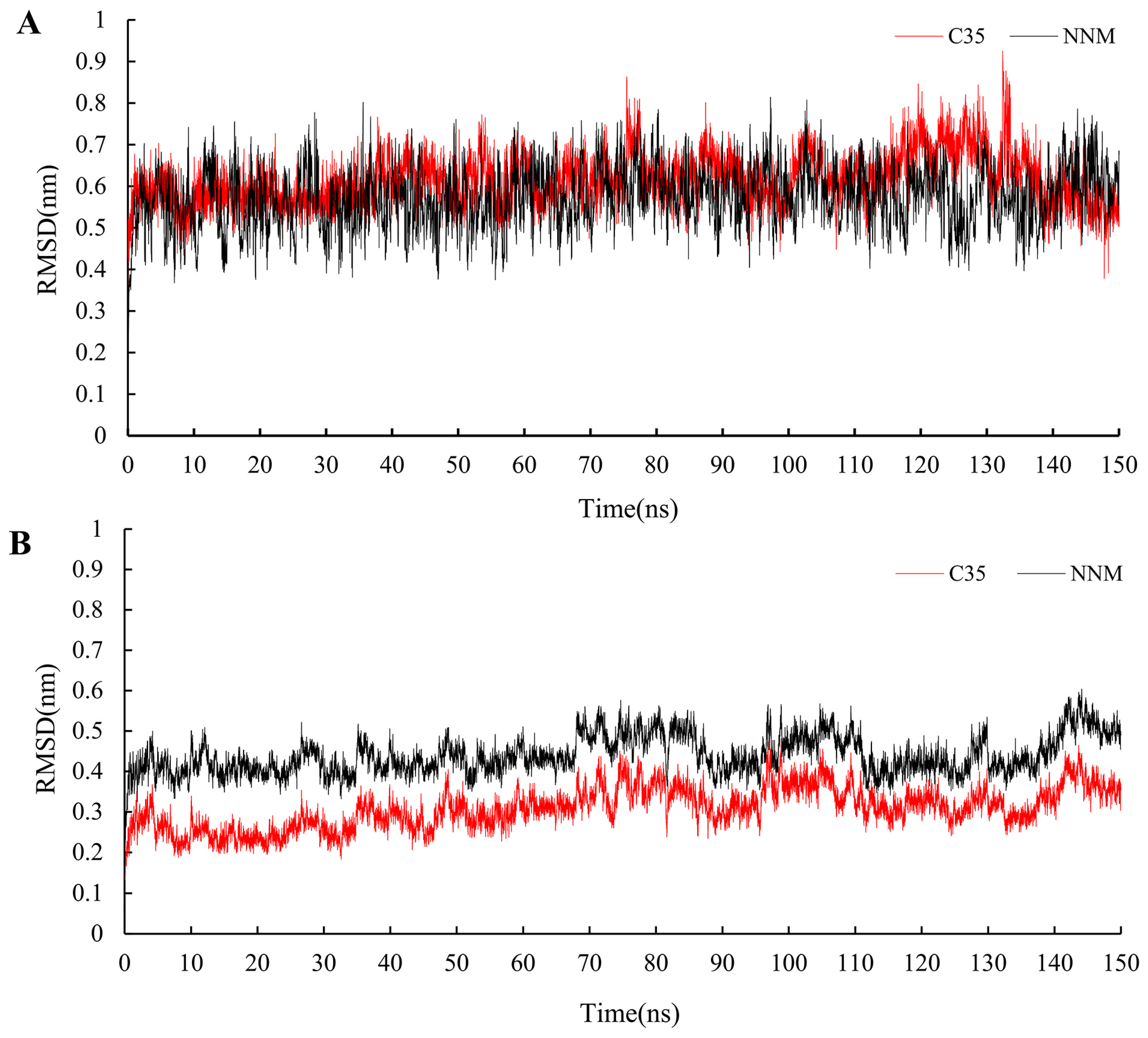
| Compd. | Curative Activity (%) a | Protective Activity (%) a | Inactivation Activity (%) a | EC50 for Inactivation Activity (μg/mL) |
|---|---|---|---|---|
| X | 28.1 ± 1.8 | 36.8 ± 4.6 | 57.4 ± 3.0 | - |
| Y | 29.1 ± 4.5 | 14.2 ± 3.8 | 39.3 ± 3.4 | - |
| Z | 39.3 ± 2.2 | 42.8 ± 3.9 | 67.1 ± 2.1 | - |
| C1 | 45.1 ± 3.5 | 34.2 ± 2.8 | 74.4 ± 3.2 | 115 ± 5 |
| C2 | 40.4 ± 3.7 | 47.3 ± 1.4 | 46.1 ± 1.8 | 566 ± 8 |
| C3 | 51.5 ± 2.2 | 46.8 ± 5.6 | 69.1 ± 3.8 | 109 ± 8 |
| C4 | 48.4 ± 2.7 | 41.4 ± 6.4 | 47.9 ± 5.8 | 531 ± 9 |
| C5 | 23.2 ± 3.6 | 63.6 ± 3.0 | 79.4 ± 5.9 | 86 ± 10 |
| C6 | 36.5 ± 2.2 | 56.3 ± 2.2 | 55.5 ± 2.2 | 466 ± 8 |
| C7 | 46.7 ± 3.4 | 56.3 ± 1.8 | 64.7 ± 4.9 | 161 ± 4 |
| C8 | 56.8 ± 1.5 | 57.1 ± 3.7 | 67.4 ± 1.2 | 176 ± 2 |
| C9 | 51.5 ± 2.1 | 56.1 ± 2.6 | 82.7 ± 4.5 | 108 ± 8 |
| C10 | 40.0 ± 3.5 | 60.1 ± 4.1 | 71.4 ± 1.5 | 133 ± 6 |
| C11 | 50.7 ± 3.0 | 42.8 ± 1.7 | 67.3 ± 2.7 | 156 ± 5 |
| C12 | 43.8 ± 5.4 | 50.4 ± 2.5 | 70.0 ± 1.9 | 147 ± 6 |
| C13 | 31.7 ± 4.6 | 41.1 ± 1.9 | 75.6 ± 4.3 | 91 ± 6 |
| C14 | 38.2 ± 4.2 | 46.2 ± 3.1 | 78.0 ± 3.8 | 109 ± 6 |
| C15 | 48.6 ± 5.2 | 42.9 ± 1.7 | 59.5 ± 5.6 | 361 ± 9 |
| C16 | 53.3 ± 2.8 | 22.4 ± 3.4 | 67.3 ± 1.5 | 445 ± 7 |
| C17 | 40.5 ± 3.7 | 48.7 ± 8.1 | 51.9 ± 4.7 | 301 ± 9 |
| C18 | 55.3 ± 1.2 | 59.5 ± 5.6 | 73.0 ± 1.1 | 143 ± 7 |
| C19 | 34.3 ± 2.1 | 60.0 ± 3.8 | 60.5 ± 2.4 | 371 ± 4 |
| C20 | 40.6 ± 1.7 | 56.9 ± 4.8 | 60.0 ± 3.3 | 295 ± 6 |
| C21 | 34.1 ± 4.5 | 52.3 ± 4.1 | 60.5 ± 1.1 | 291 ± 6 |
| C22 | 53.9 ± 1.3 | 55.3 ± 1.4 | 48.4 ± 4.1 | 449 ± 4 |
| C23 | 56.1 ± 5.1 | 46.8 ± 1.2 | 74.8 ± 3.3 | 150 ± 9 |
| C24 | 51.7 ± 2.5 | 43.3 ± 3.5 | 62.0 ± 5.2 | 284 ± 9 |
| C25 | 41.9 ± 1.9 | 46.5 ± 4.9 | 67.2 ± 8.1 | 151 ± 10 |
| C26 | 52.0 ± 3.9 | 42.2 ± 7.3 | 77.8 ± 3.5 | 116 ± 5 |
| C27 | 50.1 ± 4.8 | 49.7 ± 2.9 | 58.2 ± 3.9 | 386 ± 7 |
| C28 | 53.7 ± 0.7 | 35.2 ± 2.5 | 56.2 ± 3.1 | 464 ± 7 |
| C29 | 26.9 ± 3.3 | 49.5 ± 1.3 | 63.0 ± 1.2 | 294 ± 8 |
| C30 | 36.1 ± 3.3 | 53.0 ± 1.8 | 53.5 ± 4.2 | 405 ± 7 |
| C31 | 51.3 ± 2.4 | 52.7 ± 3.7 | 78.1 ± 4.4 | 99 ± 8 |
| C32 | 56.4 ± 5.6 | 65.5 ± 5.6 | 80.9 ± 4.4 | 85 ± 6 |
| C33 | 48.9 ± 4.6 | 64.8 ± 3.6 | 76.1 ± 2.2 | 127 ± 5 |
| C34 | 56.1 ± 4.9 | 48.3 ± 2.2 | 79.8 ± 3.5 | 83 ± 5 |
| C35 | 53.3 ± 2.5 | 56.9 ± 1.5 | 85.8 ± 4.4 | 89 ± 5 |
| Mor b | 36.7 ± 2.7 | 31.4 ± 2.0 | 57.2 ± 1.8 | 450 ± 3 |
| NNM c | 49.1 ± 2.4 | 50.7 ± 4.1 | 82.3 ± 6.4 | 72 ± 6 |
| Statistical Parameter | CoMFA | CoMSIA | Verification Standard |
|---|---|---|---|
| q2 | 0.693 | 0.632 | >0.5 |
| ONC | 2 | 2 | |
| r2 | 0.92 | 0.83 | >0.8 |
| SEE | 0.08 | 0.12 | |
| F value | 184.422 | 78.915 | |
| Steric | 0.423 | 0.075 | |
| Electrostatic | 0.577 | 0.261 | |
| Hydrophobic | 0.162 | ||
| Hydrogen-bond acceptor | 0.200 | ||
| Hydrogen-bond donor | 0.302 |
| Compd. | Exp a | CoMFA | CoMSIA | ||
|---|---|---|---|---|---|
| Pred b | Res c | Pred b | Res c | ||
| C1 | 3.605 | 3.513 | −0.092 | 3.468 | −0.137 |
| C2 | 2.966 | 3.028 | 0.062 | 3.000 | 0.034 |
| C3 | 3.663 | 3.585 | −0.078 | 3.605 | −0.057 |
| C4 | 2.985 | 2.937 | −0.048 | 3.156 | 0.171 |
| C5 d | 3.728 | 3.839 | 0.112 | 3.771 | 0.044 |
| C6 | 3.042 | 3.135 | 0.093 | 3.265 | 0.223 |
| C7 | 3.392 | 3.350 | −0.042 | 3.186 | −0.207 |
| C8 d | 3.465 | 3.628 | 0.163 | 3.492 | 0.027 |
| C9 | 3.824 | 3.711 | −0.113 | 3.731 | −0.093 |
| C10 | 3.557 | 3.553 | −0.003 | 3.341 | −0.215 |
| C11 | 3.487 | 3.395 | −0.092 | 3.426 | −0.061 |
| C12 | 3.400 | 3.401 | 0.001 | 3.427 | 0.027 |
| C13 | 3.737 | 3.749 | 0.012 | 3.774 | 0.036 |
| C14 | 3.577 | 3.642 | 0.066 | 3.698 | 0.121 |
| C15 d | 3.118 | 3.008 | −0.109 | 3.297 | 0.180 |
| C16 d | 3.034 | 3.021 | −0.013 | 2.954 | −0.080 |
| C17 | 3.187 | 3.161 | −0.026 | 3.177 | −0.011 |
| C18 | 3.444 | 3.345 | −0.099 | 3.345 | −0.099 |
| C19 | 3.096 | 3.112 | 0.016 | 3.046 | −0.050 |
| C20 | 3.202 | 3.257 | 0.054 | 3.335 | 0.133 |
| C21 | 3.206 | 3.270 | 0.064 | 3.319 | 0.113 |
| C22 d | 2.990 | 3.119 | 0.129 | 3.168 | 0.178 |
| C23 | 3.506 | 3.605 | 0.099 | 3.518 | 0.012 |
| C24 | 3.265 | 3.269 | 0.003 | 3.358 | 0.092 |
| C25 | 3.404 | 3.405 | 0.001 | 3.215 | −0.190 |
| C26 d | 3.564 | 3.408 | −0.156 | 3.423 | −0.141 |
| C27 | 3.070 | 3.118 | 0.048 | 2.984 | −0.086 |
| C28 | 3.016 | 2.981 | −0.035 | 3.165 | 0.149 |
| C29 | 3.228 | 3.271 | 0.043 | 3.203 | −0.025 |
| C30 | 3.073 | 3.137 | 0.064 | 3.040 | −0.033 |
| C31 | 3.679 | 3.710 | 0.030 | 3.651 | −0.028 |
| C32 | 3.765 | 3.805 | 0.039 | 3.769 | 0.004 |
| C33 | 3.587 | 3.580 | −0.007 | 3.625 | 0.038 |
| C34 | 3.758 | 3.639 | −0.119 | 3.745 | −0.013 |
| C35 e | 3.743 | 3.675 | −0.067 | 3.685 | −0.058 |
| Compd. | ΔEvdw | ΔEele | ΔEMM | ΔGsol | ΔEbind | −TΔS | ΔGbind |
|---|---|---|---|---|---|---|---|
| C35 a | −184.4 | −57.7 | −242.1 | 142.1 | −100.0 | 72.9 | −27.1 |
| NNM a | −145.5 | −43.8 | −189.3 | 118.4 | −70.9 | 38.5 | −32.4 |
Disclaimer/Publisher’s Note: The statements, opinions and data contained in all publications are solely those of the individual author(s) and contributor(s) and not of MDPI and/or the editor(s). MDPI and/or the editor(s) disclaim responsibility for any injury to people or property resulting from any ideas, methods, instructions or products referred to in the content. |
© 2023 by the authors. Licensee MDPI, Basel, Switzerland. This article is an open access article distributed under the terms and conditions of the Creative Commons Attribution (CC BY) license (https://creativecommons.org/licenses/by/4.0/).
Share and Cite
Bai, L.; Wei, C.; Zhang, J.; Song, R. Design, Synthesis, and Anti-PVY Biological Activity of 1,3,5-Triazine Derivatives Containing Piperazine Structure. Int. J. Mol. Sci. 2023, 24, 8280. https://doi.org/10.3390/ijms24098280
Bai L, Wei C, Zhang J, Song R. Design, Synthesis, and Anti-PVY Biological Activity of 1,3,5-Triazine Derivatives Containing Piperazine Structure. International Journal of Molecular Sciences. 2023; 24(9):8280. https://doi.org/10.3390/ijms24098280
Chicago/Turabian StyleBai, Lian, Chunle Wei, Jian Zhang, and Runjiang Song. 2023. "Design, Synthesis, and Anti-PVY Biological Activity of 1,3,5-Triazine Derivatives Containing Piperazine Structure" International Journal of Molecular Sciences 24, no. 9: 8280. https://doi.org/10.3390/ijms24098280
APA StyleBai, L., Wei, C., Zhang, J., & Song, R. (2023). Design, Synthesis, and Anti-PVY Biological Activity of 1,3,5-Triazine Derivatives Containing Piperazine Structure. International Journal of Molecular Sciences, 24(9), 8280. https://doi.org/10.3390/ijms24098280






